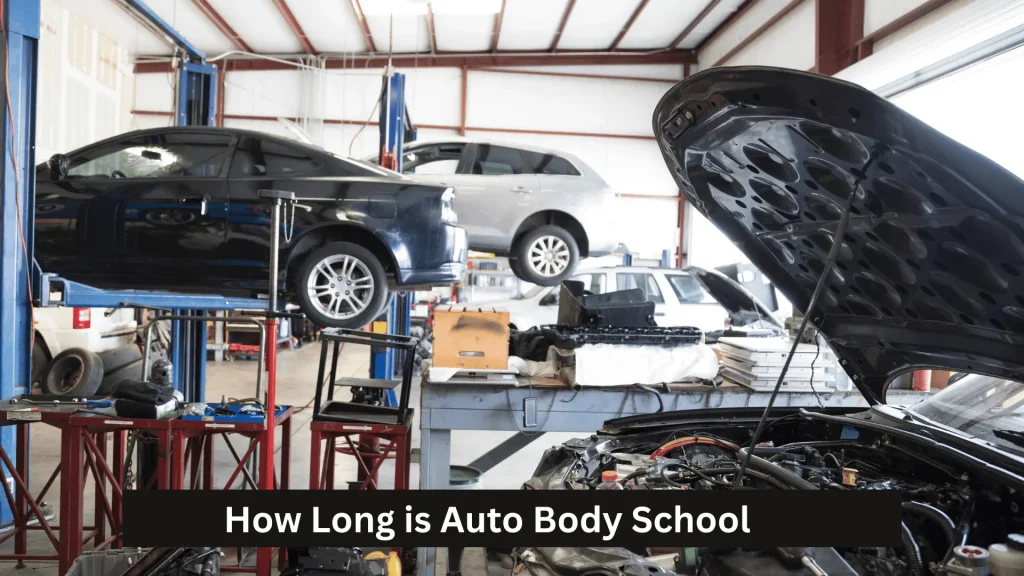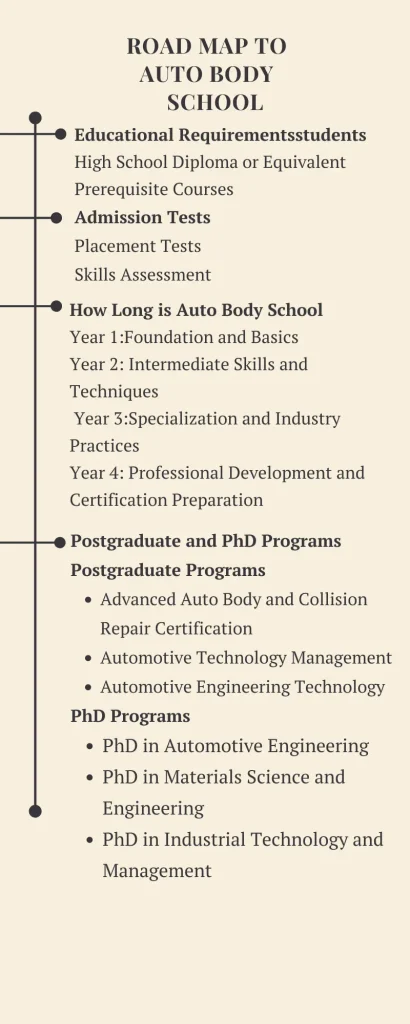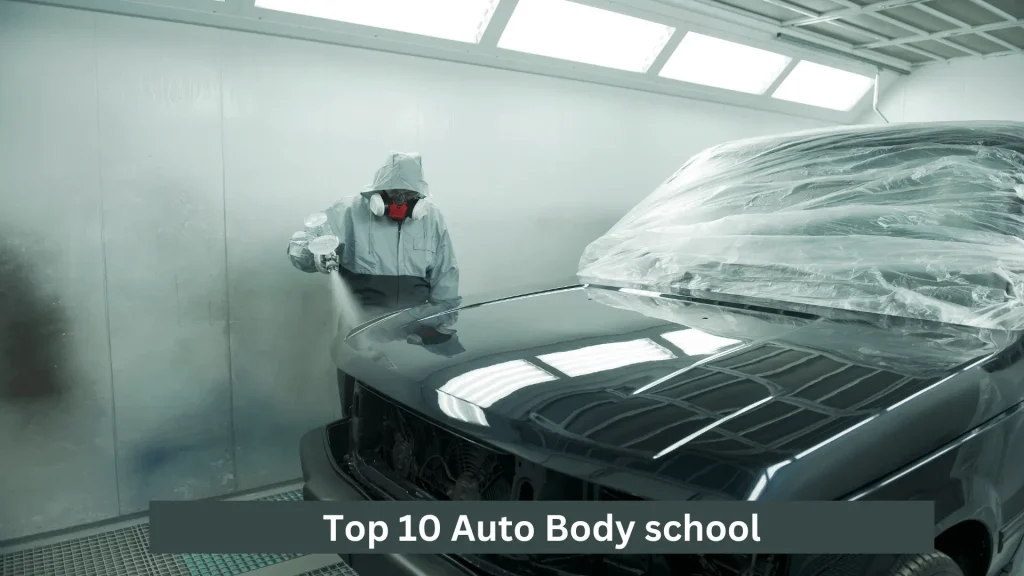How Long is Auto Body School
How Long is Auto Body School? Auto body school programs typically last between six months to two years. The duration depends on the type of certification or degree pursued. Most programs include hands-on training and classroom instruction to prepare students for careers in auto body repair and refinishing. So, how long is auto body school? It varies based on individual goals and school offerings.
What is Auto Body School
Auto body school is an educational institution that provides specialized training in the repair and restoration of vehicle bodies. Students learn to repair dents, scratches, and other damage, as well as paint and refinish vehicles. The curriculum often includes both theoretical and practical components, ensuring students gain hands-on experience with the tools and techniques used in the industry.

In addition to technical skills, auto body schools also teach students about safety protocols, customer service, and business management. Graduates of auto body programs are equipped to work in auto repair shops, dealerships, or even start their own businesses. The comprehensive training ensures they are prepared to meet the demands of the auto body repair industry.
How Long is Auto Body School
Year 1: Foundation and Basics
Introduction to Auto Body Repair: Students learn the basics of auto body repair, including safety practices, tool identification, and proper usage.
Basic Welding and Cutting: Instruction on basic welding techniques and cutting methods used in auto body repair.
Paint Preparation: Students are introduced to the fundamentals of preparing a vehicle for painting, including sanding, masking, and priming.
Year 2: Intermediate Skills and Techniques
Advanced Collision Repair: Students delve deeper into repairing significant collision damage, including frame straightening and panel replacement.
Paint Application: Detailed instruction on paint mixing, color matching, and application techniques using spray guns.
Plastic and Composite Repair: Techniques for repairing and refinishing plastic and composite materials on vehicles.
Year 3: Specialization and Industry Practices
Custom Painting and Graphics: Advanced techniques in custom paint jobs, airbrushing, and adding graphics to vehicles.
Auto Body Estimating: Training on how to estimate repair costs accurately, including using software commonly used in the industry.
Internship/Practical Experience: Many programs include a hands-on internship or practical experience in an auto body shop to apply learned skills in a real-world setting.
Year 4: Professional Development and Certification Preparation
Business Management: Courses on managing an auto body shop, customer service, and business operations.
Certification Preparation: Preparation for industry-recognized certifications such as those from the National Institute for Automotive Service Excellence (ASE).
Capstone Project: A final project showcasing the skills and knowledge acquired throughout the program, often involving a comprehensive repair and restoration project.

How to Enter Auto Body School
Educational Requirements
High School Diploma or GED: Most auto body schools require applicants to have completed high school or obtained a GED.
Basic Math and Science Skills: Understanding of basic math and science principles is often necessary, as these skills are applied in auto body repair and refinishing.
Technical Aptitude: Some programs may require a demonstration of technical aptitude through a skills assessment or prior coursework in automotive technology.
Entry Tests
Placement Tests: Some schools may require placement tests in subjects like math, reading, and mechanical comprehension to determine appropriate course placement.
Skills Assessment: Certain programs might include a practical skills assessment to evaluate an applicant’s proficiency with basic tools and techniques related to auto body work.
Application Process
Application Form: Complete the application form provided by the school, either online or in paper format.
Transcripts: Submit official high school transcripts or GED scores.
Personal Statement: Some programs may request a personal statement outlining your interest in auto body repair and your career goals.
Letters of Recommendation: Providing letters of recommendation from teachers, employers, or mentors can strengthen your application.
Interview: Some schools may require an interview as part of the admissions process to assess your interest and suitability for the program.
Financial Aids
Scholarships: Many auto body schools offer scholarships based on academic merit, financial need, or specific talents. Check with the school for available scholarships and application deadlines.
Grants: Federal and state grants, such as the Pell Grant, are available for students who demonstrate financial need. Apply through the Free Application for Federal Student Aid (FAFSA).
Student Loans: Federal student loans, including subsidized and unsubsidized loans, are available. Private student loans are also an option, though they typically come with higher interest rates.
Work-Study Programs: Some schools offer work-study programs that allow students to earn money while gaining practical experience in their field of study.
Military Benefits: Veterans and active-duty military personnel may be eligible for educational benefits through programs like the GI Bill.
Post Graduate and PhD Programs for Auto Body School
While traditional post-graduate and PhD programs specifically for auto body repair are uncommon, there are advanced educational opportunities and related fields where one can pursue further studies. Here are some possibilities:
Post Graduate Programs
Advanced Auto Body and Collision Repair Certification
Specialization Courses: Advanced courses in collision repair technology, custom painting, and restoration.
Certification Preparation: Programs designed to prepare students for advanced industry certifications, such as ASE Master Collision Repair & Refinish Technician.
Automotive Technology Management
Business and Management Skills: Focuses on managing auto body shops, customer service, and business operations.
Leadership Training: Courses on leadership and management specifically tailored for the automotive industry.
Automotive Engineering Technology
Advanced Technical Skills: In-depth courses on automotive systems, including body repair, mechanical systems, and electronics.
Research and Development: Opportunities to work on innovative projects and research in automotive technology.
PhD Programs
PhD in Automotive Engineering
Research Focus: Conduct research on vehicle design, materials science, and advanced repair techniques.
Innovation in Auto Body Technology: Work on developing new materials and methods for auto body repair and manufacturing.
PhD in Materials Science and Engineering
Material Applications: Study the properties and applications of materials used in auto body construction and repair.
Advanced Research: Research on developing stronger, lighter, and more durable materials for use in the automotive industry.
PhD in Industrial Technology and Management
Industrial Processes: Focus on improving industrial processes related to auto body manufacturing and repair.
Management Techniques: Research effective management and operational strategies for auto body shops and manufacturing facilities.
Top 10 Auto Body Schools

1.Universal Technical Institute (UTI)
Locations: Multiple campuses across the U.S.
Programs: Offers comprehensive collision repair and refinishing programs with hands-on training and industry certifications.
2.Wyoming Technical Institute (WyoTech)
Locations: Laramie, Wyoming
Programs: Provides in-depth training in collision and refinishing technology, including custom paint and graphics.
3.Lincoln Technical Institute
Locations: Multiple campuses across the U.S.
Programs: Offers auto body repair and refinishing programs with a focus on practical skills and industry-standard techniques.
4.Ohio Technical College (OTC)
Location: Cleveland, Ohio
Programs: Features programs in collision repair and refinishing technology, including specialized training in custom paint and fabrication.
5.Nashville Auto-Diesel College (NADC)
Location: Nashville, Tennessee
Programs: Offers collision repair and refinishing technology programs with a strong emphasis on hands-on training.
6.Pennsylvania College of Technology
Location: Williamsport, Pennsylvania
Programs: Provides an associate degree in collision repair technology, combining classroom instruction with practical experience.
7.College of Southern Nevada (CSN)
Location: North Las Vegas, Nevada
Programs: Offers a comprehensive auto body technology program with a focus on collision repair and refinishing.
8.Cerritos College
Location: Norwalk, California
Programs: Features an auto body repair and refinishing program with a strong emphasis on industry certifications and practical skills.
9.Eastfield College
Location: Mesquite, Texas
Programs: Provides an automotive collision repair program with specialized training in structural and non-structural repairs.
10.Ferris State University
Location: Big Rapids, Michigan
Programs: Offers a bachelor’s degree in automotive engineering technology with a focus on collision repair and refinishing.
These schools offer a range of programs from certificates to associate degrees and even bachelor’s degrees in auto body repair and refinishing, ensuring students gain the skills needed for successful careers in the auto body industry.
Factors Affecting the Length of Auto Body School
1. Type of Program
Certificate Programs: Typically last from six months to one year, focusing on foundational skills and basic techniques.
Diploma Programs: Usually span one to two years, offering more comprehensive training in collision repair and refinishing.
Associate Degree Programs: Often take two years to complete, providing in-depth knowledge and additional coursework in business management and advanced repair techniques.
2. Full-Time vs. Part-Time Enrollment
Full-Time Enrollment: Allows students to complete the program more quickly, typically within the standard duration mentioned.
Part-Time Enrollment: Extends the program length as students take fewer courses each semester, balancing education with work or other commitments.
3. Curriculum and Specializations
Basic Curriculum: Programs focused on essential skills in auto body repair and refinishing are generally shorter.
Specialized Training: Programs offering additional specializations, such as custom paint, airbrushing, or frame repair, may require more time to complete due to the extra coursework.
4. Hands-On Training Requirements
Extensive Practical Training: Programs with a significant emphasis on hands-on training and internships may take longer, as students spend more time in practical settings.
Limited Practical Training: Programs with minimal hands-on components may be shorter but might not provide as much practical experience.
5. Accreditation and Certification Preparation
Accredited Programs: Often include rigorous standards and comprehensive coursework, potentially lengthening the program.
Certification Preparation: Programs that prepare students for industry certifications, such as ASE, may take additional time to cover all necessary material.
6. School Schedule and Academic Calendar
Traditional Academic Calendar: Follows a typical semester system, with breaks and holidays, which can extend the total duration.
Accelerated Programs: Some schools offer accelerated programs with condensed schedules, allowing students to complete their studies faster.
7. Prior Experience and Advanced Placement
Credit for Prior Learning: Students with relevant work experience or previous coursework may receive credit, reducing the program length.
Advanced Placement: Schools may offer advanced placement for students who demonstrate proficiency in certain skills, shortening the time needed to complete the program.
Understanding these factors can help prospective students choose the auto body school program that best fits their goals and schedules.
Final Verdict
Choosing the right auto body school involves considering program length, specialization, hands-on training, and certification opportunities. Understanding these factors helps students select the best path to achieve their career goals in the auto body repair industry.
FAQs
1.How long does it take to complete an auto body school program?
Program lengths vary from six months for certificates to two years for associate degrees, depending on the type and specialization.
2.What are the prerequisites for enrolling in auto body school?
Most programs require a high school diploma or GED, and some may require basic math and science skills or technical aptitude.
3.What kind of financial aid is available for auto body school?
Financial aid options include scholarships, grants, federal and private student loans, work-study programs, and military benefits.
4.What certifications can I earn through auto body school?
Students can earn industry-recognized certifications such as ASE Master Collision Repair & Refinish Technician, depending on the program.
5.Are there opportunities for hands-on training in auto body school programs?
Yes, most programs include extensive hands-on training and internships to provide practical experience in real-world settings.
